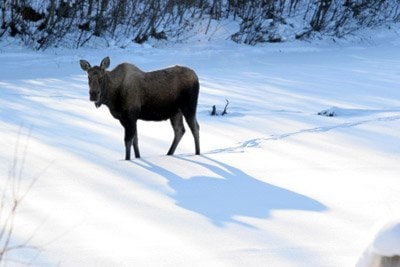The dire state of the Yukon’s Southern Lakes moose population was described in stark terms four years ago in a government-funded study.
If nothing is done, the once-thriving herd will continue to shrink, perhaps to extirpation.
Four years later, efforts to protect the herd have not begun.
The inaction of government angers Peter Percival, a longtime hunter.
He received a hunting tag to shoot a moose this year.
He doesn’t think he will use it.
“It would be unconscionable now,” he said.
“It’s not right.”
He hopes other hunters will exercise restraint as well.
But licensed hunters like Percival take few moose in the Southern Lakes region, south of Whitehorse. Only 11 hunting permits are issued, and, on average, only one or two hunters are successful.
Most moose in the area are believed to be shot by First Nation hunters. There is no limit to the number of moose that First Nation hunters may take. No records track the size of the native hunt, so it’s unclear how many moose are being shot today.
Moose in the area were once plentiful.
In 1987, the herd’s number was estimated at 1,800. In 2002, the herd’s size was believed to be 800.
That’s a 44 per cent decline.
The area was once the breadbasket of many hunters.
That was before all-terrain vehicles and snowmobiles became widely available.
Suddenly, remote areas that could only be accessed by several days of hard hiking or skiing were only an hour’s ride away.
Moose became far easier to hunt.
In the early 1980s, as many as 100 moose were being shot in Southern Lakes each year.
The Yukon government reacted in 1988 by limiting the hunt by way of issuing a small number of hunting permits.
In 2004, the wildlife branch produced a poster that suggested that action was needed to protect the herd.
“If we do nothing, there will probably continue to be fewer moose each year for ourselves and our children,” the poster says.
The poster was never released. The government of the day sat on the wildlife branch’s proposals to curb the moose hunt.
Rob Florkiewicz worked as a regional biologist for the department of environment at the time.
The proposal was never adopted by government because of land claims being negotiated at the time, he said.
The government didn’t want to talk about limiting the moose hunt until those deals had been signed.
The Umbrella agreement was finalized in 1990.
Eighteen years later, the Southern Lakes Wildlife Co-ordinating Committee, which is the product of land claim deals, is supposed to begin work on a moose plan this autumn.
The committee will likely begin consultations this fall and winter, said Florkiewicz.
Why has it taken so long?
Until now, the focus of Southern Lakes hunters and conservationists was to restore the number of caribou in the area, said Florkiewicz.
Moose had been an afterthought.
Another reason is that, with land claims, wildlife decisions are no longer supposed to be made by a single government.
The Southern Lakes wildlife committee has representatives from nine governments: six First Nations, BC government, Environment Canada and the Yukon government.
“It takes time to get people around the table,” said Florkiewicz.
“We work together. It probably takes a big longer, but you end up with a product that’s probably more successful.”
The answer offers little satisfaction to Percival.
When he moved to the Yukon 30 years ago, parts of the Southern Lakes area teemed with moose.
In recent years he has returned to his old hunting spots, and “there just weren’t any.”
He wants the government to restrict the Native moose hunt. Land claims offer provisions to do so, for valid conservation reasons.
“What do you think we’re talking about?” he asked.
Florkiewicz replies that Natives must be onside for any management plan to work.
“This is a community problem, not a department problem,” he said.
Trapping wolves may help the Southern Lakes moose population. But it would take at least 20 years for the moose population to recover.
In order for the herd to rebound any quicker, limits would need to be placed on the aboriginal hunt.
If the First Nation hunt were limited, the moose could return to a healthy number, of about 2,000, in eight years.
Voluntary limits placed on caribou in the region succeeded in allowing the herd to rebound from a low of 300 to 1,300 animals today.
But limiting hunting is never politically popular. First Nation families, which often possess little, place a high value on traditional food.
Years ago one solution was to drive down the Dempster to hunt the Porcupine caribou herd. Now that herd is in serious decline.
There are lots of bison. But some native hunters are reluctant to hunt the animals, said Florkiewicz. It’s not part of tradition. The meat tastes different.
But, Florkiewicz acknowledges if nothing is done, First Nations may find they have won control over their traditional territory, but the land may be empty of animals.
Southern Lakes once had valleys where you could find 80 moose, said Florkiewicz.
Today, you would be lucky to see one, he said.
Calls to the Carcross/Tagish and Kwanlin Dun First Nations were not returned before press time.
